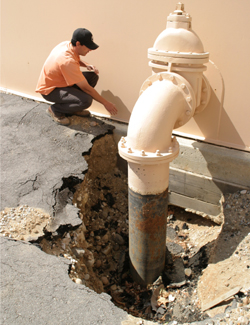Dry
An earthquake-damaged water tank, an inability to account for its
own water use, a plea for conservation — Paso Robles officials are
making drastic plans for a summer with too little water
BY ABRAHAM HYATT
PHOTOS BY CHRISTOPHER GARDNER
 |
DUST-DRY |
Paso Robles has a big problem: it's summertime, it's getting hotter, and the city might not have enough water storage to last through the hot months.
"It's not a drill. It's not just the right thing to say," Kelly Dunham, a water specialist with the city, said. "We are going to be in a serious situation this summer if we're not able to conserve."
Officials aren't saying there's not enough water; the city's wells still produce more water than the residents, businesses, parks, hospitals, jails, vineyards, and cemeteries use.
But they are saying that those tens of thousands of taps might see a drastic change in pressure if conservation efforts don't work.
Those interested in a scapegoat to the problem have one simple answer: the Dec. 22 earthquake.
The damaged tank
On the east side of Paso, there's an empty 4-million-gallon water tank.
It sits 15 feet away from another almost identical tank. Each is 40 feet high and 131 feet across. Fifteen columns hold up the ceilings and innumerable cross beams. The walls are constructed from inches-thick steel made to withstand the pressure of more than 33 million pounds of water.
From the outside, they look identical: salmon-colored, gargantuan, immobile.
But there is one key difference: When the city built Tank Two - as the southernmost behemoth is called - in 2000, they encircled the base with a concrete ring. They didn't think that was necessary in 1972 when they built its counterpart, Tank One.
And last Dec. 22, that detail made all the difference.
About 45 minutes before noon, a 6.5-magnitude earthquake slammed along the coast, destroying buildings, injuring dozens of people, and killing two women in downtown Paso Robles.
As the ground pitched, the water inside the almost-full tanks rocked up and down in four-foot waves. Outside Tank Two, pipes wrenched apart; inside, joints and beams held strong. Over at Tank One, similar pipes were damaged, but inside, things weren't going as well.
With each vacillation of the ground, the tank swayed from side to side. Finally, one multimillion-pound side lifted free of the ground and smashed back down. Thick steel walls bulged. Support columns jerked to one side. Beams along the roof shifted 10 inches.
Six months after the earthquake, Justin Ezell - a specialist with the city's water department - stood inside the cavernous interior of Tank One and described the aftermath. He estimated he arrived at the tanks about 15 minutes after the ground stopped shaking. Waves inside each tank were still about four feet high.
Outside Tank One, a city's summer was leaking away.
Ezell said his department sent a sterilized diver into tank number two to confirm its safety and then bypassed or repaired the damage to the pipes so they could keep it operational. But they didn't have the same luck with Tank One. Because of the damaged pipes and noticeably buckled sides, the city conducted a controlled drain to release what water remained in the tank. Once inside, they discovered the additional damage.
The repair process starts with a presentation water officials will give at an early July Paso Robles city council meeting. After that, they don't expect the tank to be operational until 2005.
Standing on its bone-dry floor, Ezell had to think for a moment when asked what could have happened if the earthquake had actually ruptured the tank's sides.
"I don't know," he said, shaking his head.
 |
LADY OF THE WATER |
Paso's biggest users
Kelly Dunham is actually happy about how the tanks performed: They did their job, he said. The water stayed in; they didn't collapse.
Dunham, Ezell, and three other men run the department that brings water to the city's 26,000 residents.
And despite the fact that there are 14 wells, five booster stations, 148 miles of water pipe, three 4-million-gallon reservoir tanks, one 150,000-gallon reservoir tank, and more than 10,000 meters, the system they run is actually quite simple.
Think of it as a loop: at one end are the many wells. At the other are the massive storage tanks. In between are thousands of users.
During daylight hours, residents wash cars, water lawns, manufacture goods, take showers, cook meals, and wash clothes. During the summer, higher temperatures dictate higher demand.
The water they use comes from two places: inside the loop and inside the tanks. It's actually easy to watch that process: During peak hours, the water-level marker on the reservoir tanks can drop more than four feet.
When the city's customers shut off their faucets at night, the wells keep pumping and the excess fills the tanks again. The next morning, the cycle starts all over. The extra water in the tanks ensures that there will be enough water for everyone, and that each customer's water pressure will remain the same.
Now, imagine almost a third of that storage capacity gone.
According to Dunham, the demand this winter and spring has been low enough for the tanks to refill each night. But when the heat starts, he said, the demand will get too high and there won't be enough time to refill the tanks to their proper level.
If that happens consecutive days, he said, "then the tank keeps going down, down, down, down, and we'll never be able to fill it back up. That could be serious."
One easy way to solve the problem would be to find the city's top users and ask them to cut back.
New Times recently asked Paso's public works department to provide such a list. Interim public works director Meg Williamson was more than happy to comply. In fact, she was in the process of compiling such a list to present to the city council.
But Williamson found the concept simpler than the execution.
First, the city doesn't have a database of users; they have 10,000-plus billing records. Second, the city bills half the city on alternate two-month periods - a fact that created more confusion when they were trying to determine last summer's peak users. Additionally, many of the top users have different meters for landscaping and for interior use.
On top of all that, Paso Robles itself - one of the city's top users - is unable to monitor its own usage. According to Williamson, the city doesn't bill itself for its own water and it hasn't replaced worn-out and slow meters across the city.
As she put it, "[Our own meters] really weren't important until we started looking at how to conserve."
What Williamson and her department now have is a list of the city's top water consumers - see sidebar - but they still can't confirm how much each uses.
 |
ONCE BROKE, NOW FIXED Justin Ezell, a specialist with Paso Robles’ water department, points to where a pipe into a 4-million-gallon water tank tore apart in last December’s earthquake. |
Worst-case scenario
Despite their difficulty in compiling top users, Williamson and her staff already have a plan they hope will provide relief.
First off, they've instigated an almost $40,000 water-conservation ad campaign. That includes inserts in every water bill, posters around town, and commercials on local radio and in local newspapers.
"We want to help people [conserve] and not necessarily penalize them," Dunham said. "We'd rather take a more positive approach and help them see ways to [save]."
But Dunham and Williamson were both hesitant to put all their faith in conservation.
Like Williamson said, "I don't think that's reality; people just don't change their habits."
So the city has a backup plan: First, they're monitoring the reservoirs on a weekly basis. If the level in those tanks gets too close to a predetermined level (one that maintains enough water for emergency fire use), then they're going to call the city's top users.
Dunham and Williamson said they've already approached many of them and asked them to cut back. But they can only ask - there are no mandatory restrictions, no penalties for overuse. Plus, Dunham said, even if there were regulations in place, the water department doesn't have the staff to enforce them.
So if things get bad, officials can only call the top users and ask them to drastically reduce their usage. Hopefully, that will save enough to keep reservoir tanks a safe level.
If it doesn't, the city will shut the tanks off. And that's when things will serious.
Officials said taps will never go dry: The city's wells produce enough water to ensure that will never happen. But water pressure will dramatically decrease across the city.
Beyond that drop in pressure, officials don't know what's going to happen. They've never done this before.
"We're in a situation where we have to put an urgency message out. And we hope it doesn't leave a bad taste in people's mouth because this [should] be something that's ongoing," Williamson said. "It's just a conscientious thing to do with a valuable resource."
For its own part, Williamson said the city would be able to track its own usage within the next few weeks. They've cut back on the amount their Parks and Recreation Department uses by about 25 percent. They've also done little things like remove turf from under the trees in certain parks and replace it with wood chips.
"You can drive around now and see how much we've cut back on our water. It's starting to show," she said.
The city is even paying attention to its toilets in city hall. The units lack an upper tank so the traditional "brick in the tank" conservation trick doesn't work. Instead, officials have done the next closest thing: They've installed waterless urinals in the men's bathroom.
Men who use the urinals are greeted with a small, almost eye-level sign informing them they're helping the city save about 45,000 gallons of water a year. ³
Staff Writer Abraham Hyatt can be reached at [email protected].